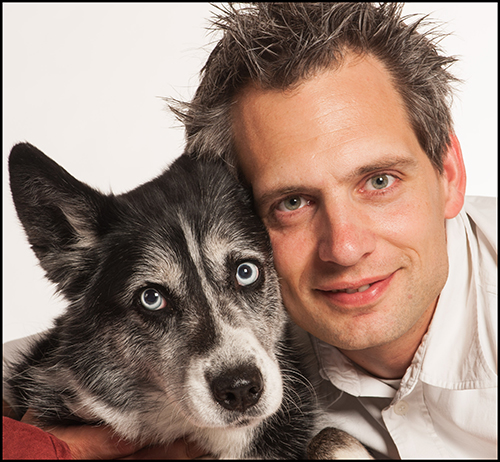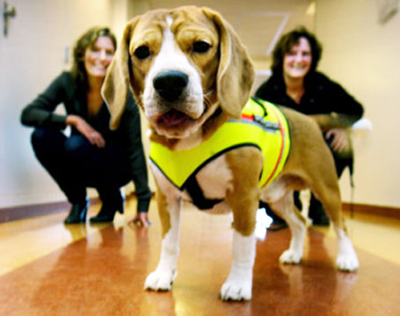Thailand Researchers Train Labrador Retrievers to Detect COVID-19 in Human Sweat
This is yet another example that dogs can be highly accurate screeners for disease. But are they ready to be included in clinical laboratory diagnostic tests?
Thailand researchers have trained dogs to screen for COVID-19 infections in humans, despite the country’s “spicy and flavorful cuisine,” the AP reported. This is just the latest example of a country using dogs to identify individuals who are infected with the SARS-CoV-2 coronavirus. Clinical laboratory managers and pathologists have seen other examples of dogs being trained to identify different diseases or health conditions.
In fact, dogs have been shown to be highly accurate at spotting disease in humans and the practice is becoming common worldwide. But could dogs achieve the required clinical accuracy and reproducibility in detecting disease for the procedure to be translated into clinical practice?
Smelling Disease as a Clinical Laboratory Diagnostic
Clinical laboratory professionals are quite familiar with the concept of the human body producing volatile chemicals that can serve as biomarkers for disease or illness. Dark Daily has previously reported on multiple breath/aroma-based diagnostic clinical laboratory tests going as far back as 2013.
We even reported on a woman in the UK who could smell Parkinson’s Disease in patients long before the appearance of any symptoms.
But it is in the use of dogs to spot COVID-19 infections in humans where this type of breath/aroma-based diagnostic test research is making a notable impact.
In “German Scientists Train Dogs to Detect the Presence of COVID-19 in Saliva Samples; Can a Canine’s Nose Be as Accurate as Clinical Laboratory Testing?” we covered how after only one week of training, dogs in Germany were able to accurately detect the presence of the COVID-19 infection 94% of the time!
“Even if this approach were not warranted as a clinical diagnostic procedure, trained dogs could be deployed at airports, train stations, sporting events, concerts, and other public places to identify individuals who may be positive for SARS-CoV-2, the coronavirus that causes the COVID-19 illness,” we wrote. “Such an approach would make it feasible to ‘screen’ large numbers of people as they are on the move. Those individuals could then undergo a more precise medical laboratory test as confirmation of infections.”
Now, researchers at the Faculty of Veterinary Science at Bangkok’s Chulalongkorn University have successfully trained dogs to sniff out the disease by smelling human sweat samples.
According to the researchers, individuals with a COVID-19 infection emit a unique odor that is present in sweat samples. The six Labrador retrievers used in the research were able to detect the presence of COVID-19 with an impressive 95% accuracy rate in more than 1,000 samples presented to them, the AP reported.

A Labrador Retriever named Bobby (above) sniffs sample of human sweat through containers to detect COVID-19 coronavirus at Veterinary Faculty, Chulalongkorn University in Bangkok. Thailand has deployed a canine virus detection squad to help provide a fast and effective way of identifying people with COVID-19 as the country faces a surge in cases, with clusters found in several crowded slum communities and large markets. Clinical laboratory professionals and pathologists will find it interesting that the dogs are given a sample of sweat, each presented in a unique container. Thus, the dogs never are in the presence of the humans who provided the specimens. (Photo and caption copyright: AP/Sakchai Lalit)
To perform the study, the scientists placed sweat samples in metal containers and allowed the dogs to sniff each sample. If no trace of the infection was present, the dogs simply walked past the container. If the disease was detected in a particular sample, the dogs would sit down in front of the container.
Would Spicy Food Interfere with Dogs’ Ability to Detect COVID-19?
The head of the research team, Professor Kaywalee Chatdarong, PhD, noted that other countries also have been using canines to detect the presence of COVID-19. She did have some concerns that the utilization of dogs for this purpose may not work in Thailand due to their often-spicy cuisine. However, since the samples used were from students and faculty at the university, as well as people from the surrounding area, the cuisine did not seem to affect the study results, the AP reported.
Thailand is facing a surge in COVID-19 cases with recent clusters reported at construction sites, crowded neighborhoods, and large markets. The research team plans to use the canines in mobile units in communities suspected of being hotspots for the disease.
A major plus of using dogs to sniff out the disease from sweat samples is the ability to test people who may not be able to get out of their homes to be tested.
“People can simply put cotton balls underneath their armpits to collect sweat samples and send them to the lab,” Suwanna Thanaboonsombat, a volunteer who collects samples and brings them to the clinical laboratory for testing, told the AP. “And the result is quite accurate.”
According to the US Centers for Disease Control and Prevention (CDC), dogs can become infected with the SARS-CoV-2 coronavirus. However, their chances of transmitting the disease to humans is extremely low. Nevertheless, to ensure the dogs do not become infected with COVID-19 themselves, the researchers designed the sample containers to avoid contact between the samples and the dogs’ noses.
Living Animals Come with Limitations
While dogs can provide a quick and inexpensive method of testing for COVID-19, they do have limitations.
“5 p.m. is their dinner time. When it’s around 4:50, they will start to be distracted. So, you can’t really have them work anymore,” Chatdarong told the AP. “And we can’t have them working after dinner either because they need a nap. They are living animals and we do have to take their needs and emotions into consideration. But for me, they are heroes and heroines.”
Using Dogs to Detect COVID-19 in Other Countries
Last fall, the Helsinki Airport in Finland announced it would use a team of trained dogs to detect the presence of COVID-19 among visitors to the airport to ensure the health and safety of its customers and their families, and to help prevent the spread of SARS-CoV-2 in Finland.

Being tested for the coronavirus at the Helsinki airport in Finland does not require direct contact with a dog. Individuals simply need to swipe their skin with a test wipe and drop the wipe into a cup. The cup is then given to a dog that is working in a separate booth (shown above), which protects both the dog and the dog’s handler from contamination. All tests are processed anonymously and anyone testing positive for COVID-19 is directed to a health information point located at the airport. (Photo copyright: Finavia.)
“We are among the pioneers. As far as we know no other airport has attempted to use canine scent detection on such a large scale against COVID-19,” said Airport Director Ulla Lettijeff in a Finavia press release. “This might be an additional step forward on the way to beating COVID-19.”
In addition to being “man’s best friend,” dogs serve valuable purposes in the medical community. Their strong sense of smell may render them useful in the detection of and fight against illnesses, including COVID-19.
Whether the performance and accuracy of individual dogs can be validated with acceptable quality control (QC) procedures remains to be seen. Medical laboratory managers and pathologists understand the challenges presented with demonstrating accuracy and reproducibility with this method of diagnostic testing. That obstacle has prevented research outcomes from being translated into clinical practice.
—JP Schlingman
Related Information
Sniffing Labrador Retrievers Join Thai Coronavirus Fight
Sniffing Dogs Join Coronavirus Fight in Various Studies and Trial Programs
COVID-19 Dogs Arrive at the Airport—Able to Identify the Virus Earlier than Laboratory Tests
Coronavirus Disease 2019 (COVID-19) Factsheet: What You Need to Know about COVID-19 and Pets
Trained on Smelly Socks, Bio-Detection Dogs Sniff Out COVID-19
Switzerland Trains Sniffer Dogs for Detecting COVID-19
Dogs in Germany Trained to Sniff Out COVID-19 in Humans, Researchers Say





